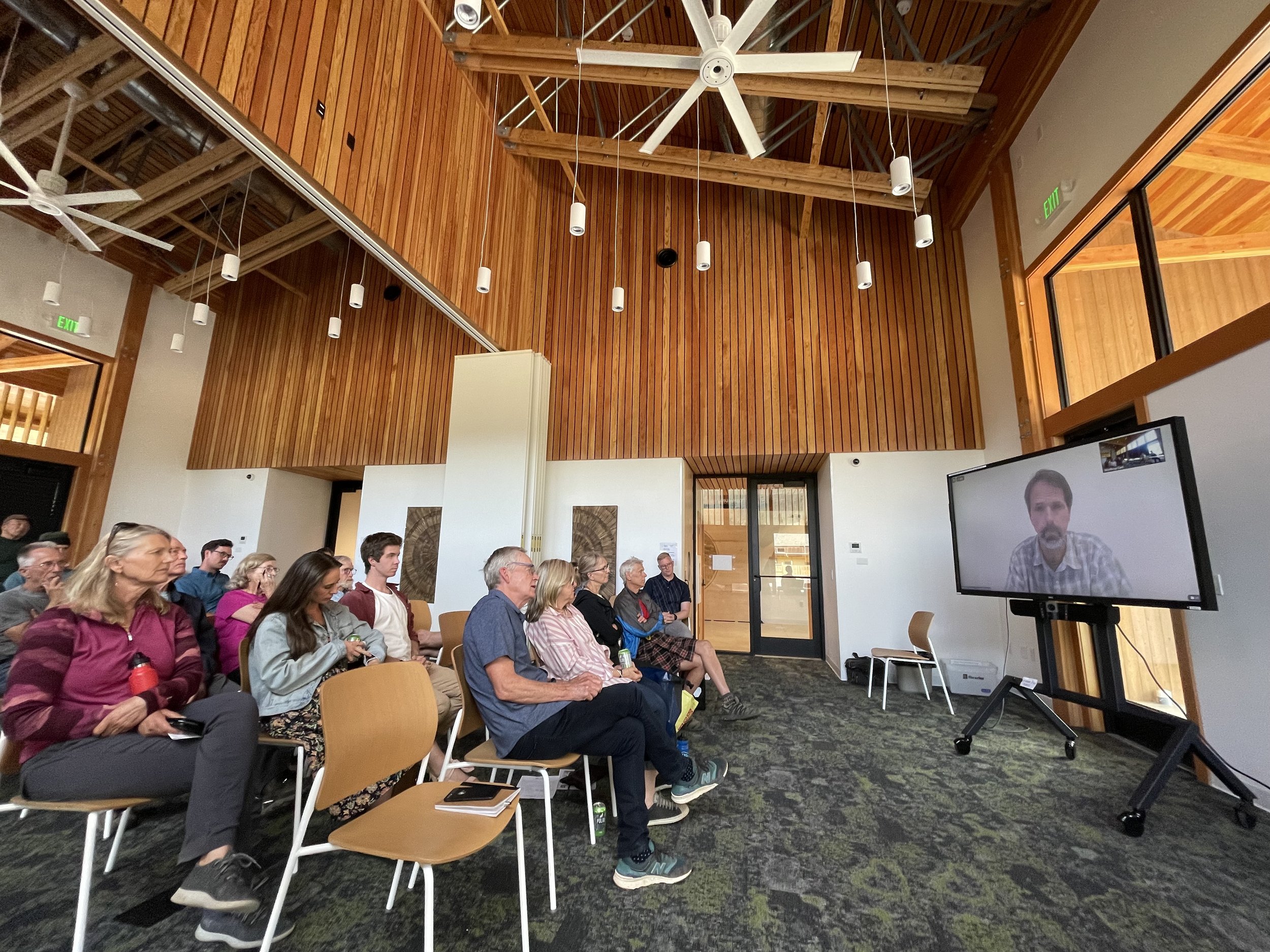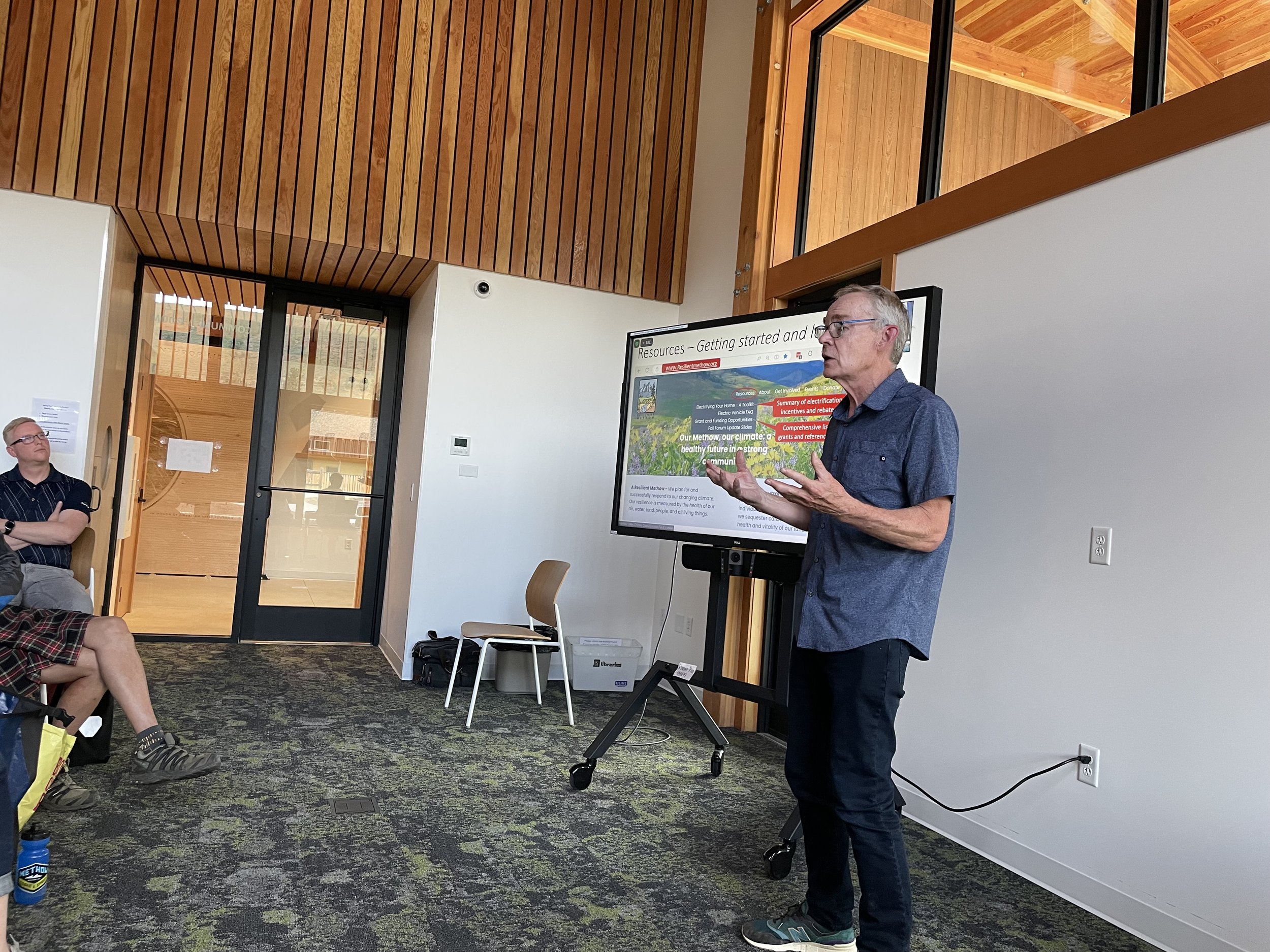Forum Summary and Resources: Electrify Your Home 5/25
Summary by Dylan Braund
Watch the recording here.
Resilient Methow’s Home Electrification Forum included five guest speakers who shared their knowledge about home electrification processes, benefits, and incentives. Rahul Young form Rewiring America made the case for home electrification and discussed its connection to climate solutions well as what home electrification on a national level might look like. Liz Reichart from the Washington State Department of Commerce’s Energy Office shared what the implementation of the Inflation Reduction Act’s rebates for home electrification will look like. Greg Mendonca, the general manager of Okanogan County Electric Co-Op discussed the infrastructure considerations of increased electrification, followed by Murray Taylor, a volunteer with Resilient Methow, who reviewed Resilient Methow’s toolkit for home electrification. Finally, Mike Stenberg from Cascade Mechanical reviewed heat pump benefits from the perspective of a local contractor. See below for key takeaways from each of their presentations.



Rahul Young: Rewiring America
View Rahul’s presentation slides here.
Because 42% of energy-related emission come from “around the kitchen table” decisions made by homeowners (such as what cars to buy or which water heater to purchase), the goal of Rewiring America is to make it as easy and affordable for people to electrify their homes. With technology improvements, the production of clean electricity is more affordable and abundant than ever, and the price of renewable energy (particularly solar and wind) has dropped in recent years. Home electrification can provide climate benefits while lowering energy costs and creating jobs in the community that cannot be offshored or automated. Switching away from gas appliances such as indoor gas stoves can also improve the air quality in the home.
So, what can you do? Rewiring America provides a savings calculator to assist people in determining benefits that they can receive for home electrification. You can talk about home electrification with your friends and neighbors or reach out to your local school districts to encourage them to investigate electrification. Finally, reaching out to your local government officials and encouraging them to support policies related to electrification can help to inspire change on a broader scale (check out the “Local Government Leaders for Electrification” page to learn more).
Liz Reichart: Washington State Department of Commerce
Download Liz’s slides here.
The Inflation Reduction Act (IRA) provides funding for clean energy and climate-related solutions across the country including home efficiency rebates, home electrification rebates, and contractor training. In Washington State, the building sector is the second-highest source of emissions (behind transportation) and both state and local governments have recognized that investing in building efficiency is the most cost-effective way to reduce emissions. Customer rebate programs through the IRA include rebates for high-efficiency electrification projects at the point of sale (water heaters, dryers, heaters, electric stoves, etc.) as well as whole-home efficiency rebates applying to energy-saving retrofits for an entire house.
Although rebates are not yet available (and are not retroactive), current planning for the program is underway and rebates will likely begin to be implemented in 2024. However, federal tax credits renewed under the IRA are currently in effect and more information can be found on the IRS’s “Clean Energy Tax Credit” page. To get involved in shaping the rebate process, sign-ups for public listening sessions are available on the Department of Commerce’s “Federal Funding for Buildings” page.
Greg Mendonca: Okanogan County Electric Co-Op
The shift towards electrification will require a significant investment of resources. The existing infrastructure in Okanogan County is not yet suitable for an “electrify everything” movement and improvements in infrastructure must be made. Additionally, electric companies must anticipate the shift away from fossil-fuel based energy and be ready to accommodate increased electrification in homes and businesses. For homeowners, a good place to start in the journey to electrification is replacing less efficient windows and doors with more energy-efficient ones. Rebates for ductless heat pumps to replace less efficient electric heating systems are also something to look into, though this must be done through a licensed contractor (see the Okanogan County Electric Co-Op website for a list of approved contractors).
Murray Taylor: Resilient Methow
For information regarding home electrification, be sure to check out Resilient Methow’s toolkit for home electrification (linked below). This document provides a summary of ways to move towards home electrification and includes information regarding savings through the IRA, local electric utilities, and federal, state, and local programs supporting home electrification. There is also a summary of electrification incentives and rebates available as well as a comprehensive list of grants and reference information.
Mike Stenberg: Cascade Mechanical
Progress towards the electrification of heating and cooling systems in Okanogan County has been made in the past two decades and 98% of Cascade Mechanical’s installations are now ductless heat pump systems. An air source heat pump is an air conditioner with a reversing valve that can both heat and cool an indoor space. Instead of removing heat the way that an air conditioner does, a heat pump collects heat from the outdoor air (even in the winter) and delivers it into the home. On average, heat pumps are 30% more efficient than baseboard, wall, or electric heaters. If a homeowner does not want to entirely switch over from propane heating, a dual-heat solution is also available and the installation of a heat pump can be coupled with a gas furnace. Because of the recent improvements in heat pump technology, heat pumps are effective and quiet, even when faced with very cold outdoor temperatures, and little or no backup heat source is required.
Resources and Links
Rewiring America: Main Website https://www.rewiringamerica.org/
Rewiring America: Inflation Reduction Act Calculator https://www.rewiringamerica.org/app/ira-calculator
Rewiring America: Local Government Leaders for Electrification https://www.rewiringamerica.org/local-gov-leaders-for-electrification
IRS: Clean Energy Tax Credit https://www.irs.gov/credits-deductions/residential-clean-energy-credit
Washington State Department of Commerce: Federal Funding for Buildings https://www.commerce.wa.gov/growing-the-economy/energy/federal-funding-for-buildings/
Okanogan County Electric Co-Op https://ocec.coop/
Resilient Methow: Electrification incentives and rebates https://www.resilientmethow.org/electrify-your-home
Resilient Methow: Grants and reference information https://www.resilientmethow.org/resourcesandgrants
Cascade Mechanical https://www.cascademechanical.com/
Okanogan County PUD https://www.okanogancountypud.org
